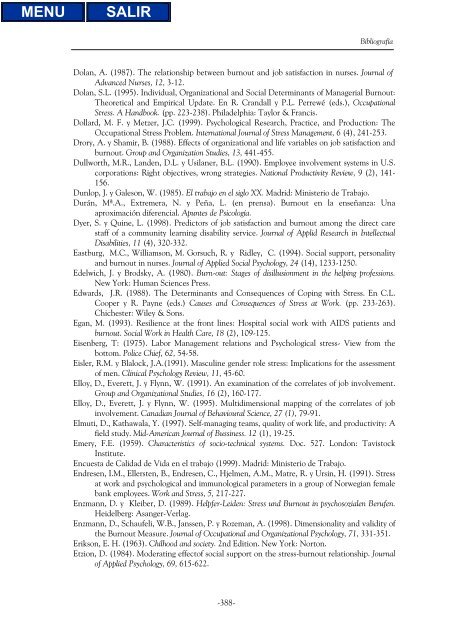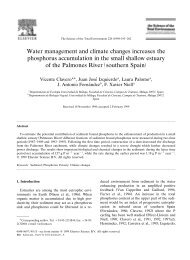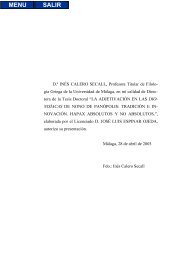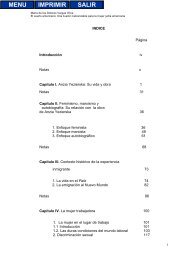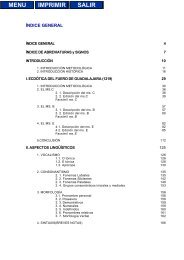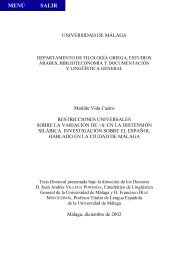El Síndrome de Burnout en organizaciones policiales - Biblioteca ...
El Síndrome de Burnout en organizaciones policiales - Biblioteca ...
El Síndrome de Burnout en organizaciones policiales - Biblioteca ...
Create successful ePaper yourself
Turn your PDF publications into a flip-book with our unique Google optimized e-Paper software.
-388-<br />
Bibliografía<br />
Dolan, A. (1987). The relationship betwe<strong>en</strong> burnout and job satisfaction in nurses. Journal of<br />
Advanced Nurses, 12, 3-12.<br />
Dolan, S.L. (1995). Individual, Organizational and Social Determinants of Managerial <strong>Burnout</strong>:<br />
Theoretical and Empirical Update. En R. Crandall y P.L. Perrewé (eds.), Occupational<br />
Stress. A Handbook. (pp. 223-238). Phila<strong>de</strong>lphia: Taylor & Francis.<br />
Dollard, M. F. y Metzer, J.C. (1999). Psychological Research, Practice, and Production: The<br />
Occupational Stress Problem. International Journal of Stress Managem<strong>en</strong>t, 6 (4), 241-253.<br />
Drory, A. y Shamir, B. (1988). Effects of organizational and life variables on job satisfaction and<br />
burnout. Group and Organization Studies, 13, 441-455.<br />
Dullworth, M.R., Lan<strong>de</strong>n, D.L. y Usilaner, B.L. (1990). Employee involvem<strong>en</strong>t systems in U.S.<br />
corporations: Right objectives, wrong strategies. National Productivity Review, 9 (2), 141-<br />
156.<br />
Dunlop, J. y Galeson, W. (1985). <strong>El</strong> trabajo <strong>en</strong> el siglo XX. Madrid: Ministerio <strong>de</strong> Trabajo.<br />
Durán, Mª.A., Extremera, N. y Peña, L. (<strong>en</strong> pr<strong>en</strong>sa). <strong>Burnout</strong> <strong>en</strong> la <strong>en</strong>señanza: Una<br />
aproximación difer<strong>en</strong>cial. Apuntes <strong>de</strong> Psicología.<br />
Dyer, S. y Quine, L. (1998). Predictors of job satisfaction and burnout among the direct care<br />
staff of a community learning disability service. Journal of Applid Research in Intellectual<br />
Disabilities, 11 (4), 320-332.<br />
Eastburg, M.C., Williamson, M. Gorsuch, R. y Ridley, C. (1994). Social support, personality<br />
and burnout in nurses. Journal of Applied Social Psychology, 24 (14), 1233-1250.<br />
E<strong>de</strong>lwich, J. y Brodsky, A. (1980). Burn-out: Stages of disillusionm<strong>en</strong>t in the helping professions.<br />
New York: Human Sci<strong>en</strong>ces Press.<br />
Edwards, J.R. (1988). The Determinants and Consequ<strong>en</strong>ces of Coping with Stress. En C.L.<br />
Cooper y R. Payne (eds.) Causes and Consequ<strong>en</strong>ces of Stress at Work. (pp. 233-263).<br />
Chichester: Wiley & Sons.<br />
Egan, M. (1993). Resili<strong>en</strong>ce at the front lines: Hospital social work with AIDS pati<strong>en</strong>ts and<br />
burnout. Social Work in Health Care, 18 (2), 109-125.<br />
Eis<strong>en</strong>berg, T: (1975). Labor Managem<strong>en</strong>t relations and Psychological stress- View from the<br />
bottom. Police Chief, 62, 54-58.<br />
Eisler, R.M. y Blalock, J.A.(1991). Masculine g<strong>en</strong><strong>de</strong>r role stress: Implications for the assessm<strong>en</strong>t<br />
of m<strong>en</strong>. Clinical Psychology Review, 11, 45-60.<br />
<strong>El</strong>loy, D., Everett, J. y Flynn, W. (1991). An examination of the correlates of job involvem<strong>en</strong>t.<br />
Group and Organizational Studies, 16 (2), 160-177.<br />
<strong>El</strong>loy, D., Everett, J. y Flynn, W. (1995). Multidim<strong>en</strong>sional mapping of the correlates of job<br />
involvem<strong>en</strong>t. Canadian Journal of Behavioural Sci<strong>en</strong>ce, 27 (1), 79-91.<br />
<strong>El</strong>muti, D., Kathawala, Y. (1997). Self-managing teams, quality of work life, and productivity: A<br />
field study. Mid-American Journal of Bussiness. 12 (1), 19-25.<br />
Emery, F.E. (1959). Characteristics of socio-technical systems. Doc. 527. London: Tavistock<br />
Institute.<br />
Encuesta <strong>de</strong> Calidad <strong>de</strong> Vida <strong>en</strong> el trabajo (1999). Madrid: Ministerio <strong>de</strong> Trabajo.<br />
Endres<strong>en</strong>, I.M., <strong>El</strong>lerst<strong>en</strong>, B., Endres<strong>en</strong>, C., Hjelm<strong>en</strong>, A.M., Matre, R. y Ursin, H. (1991). Stress<br />
at work and psychological and immunological parameters in a group of Norwegian female<br />
bank employees. Work and Stress, 5, 217-227.<br />
Enzmann, D. y Kleiber, D. (1989). Helpfer-Lei<strong>de</strong>n: Stress und <strong>Burnout</strong> in psychosozial<strong>en</strong> Beruf<strong>en</strong>.<br />
Hei<strong>de</strong>lberg: Asanger-Verlag.<br />
Enzmann, D., Schaufeli, W.B., Janss<strong>en</strong>, P. y Rozeman, A. (1998). Dim<strong>en</strong>sionality and validity of<br />
the <strong>Burnout</strong> Measure. Journal of Occupational and Organizational Psychology, 71, 331-351.<br />
Erikson, E. H. (1963). Chilhood and society. 2nd Edition. New York: Norton.<br />
Etzion, D. (1984). Mo<strong>de</strong>rating effectof social support on the stress-burnout relationship. Journal<br />
of Applied Psychology, 69, 615-622.


